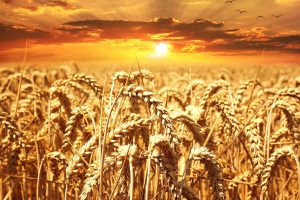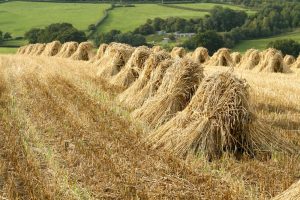Lammas is also known as: Lughnasadh (Old Irish Lunasa means August), Calan Awst (Welsh, first day of August), Gwyl Awst (Welsh, feast of August) and Feast of First Fruits (Anglo-Saxon Chronicle). It is claimed that the word Lammas is Anglo-Saxon, hlaf-mas = loaf-mass (although this is probably a modern-day creation.
Celebrated on 01st August
What is Lammas?

Lammas is the first of three harvest festivals, it is the very beginning of the harvest period. From now onwards farmers will be watching their grain crop and the weather closely. They need sunny, warm, dry weather to finish the ripening process of the grain and they cannot harvest when the grain is wet as it will rot.
At Lammas everything is poised and waiting, waiting for that perfect moment when the crop is at is optimal best and the weather is right. In Britain this does not occur according to a date on a calendar; the weather is a fickle thing.The start of harvest means that we are moving into a time of plenty.
When the harvest was brought in by hand it would take many people to fulfill the task and at this time they would be gathering ready to pounce when the conditions were right. Whilst they were waiting they would have time on their hands and being ‘in good cheer’, with life full of promise they would amuse themselves and make merry with games and celebrations. The celebration of Lammas is about making merry and playing games.
The Moon at Lammas
The old name for the moon in August on the mainland of the British Isles is ‘Grain Moon’ or ‘Dispute Moon’. The name Grain Moon is obvious; this is the month in which the grain crops become ready to harvest. For the name ‘Dispute Moon’ we have to go back in time to the common practices at Lammas (see ‘Historical Context’ below).
Historical Context & Traditions
Lammas is traditionally the time for ‘hiring fairs’ also known as ‘Mop Fairs’. They were born out of Edward III’s attempt to regulate the labour market with the ‘Statute of Labourers’ in 1351 due to the national shortage of labour following the black-death.
Their main focus was the matching of workers with employers for the imminent harvest. However they soon turned into major feasts in their own right with all the other trappings of a fair and a reputation for drunkenness and immorality (a bit like town centres on a Saturday night today).
Lammas is also the traditional time for settling disputes. None more so than those over ‘Lammas Grazing Rights’; these are a part of our ‘Common Land’ laws whereby people (commoners), have certain traditional rights to land (such as grazing their livestock, collecting firewood or cutting turf) owned by another. The Lammas rights entitled commoners to pasture (graze their animals) following the hay harvest, between Lammas day, (12 August) and 6 April, even if they did not have other rights to the land.Hay is harvested a good month before grain crops and the date of 12 August for Lammas Day is from old Julian calendar which now occurs on 01 August. Lammas grazing rights are still in existence today.

If you were in Anglo-Saxon England it was customary to make a loaf from the very first grains to be harvested. After the loaf was blessed in church you may very well be required to employ it to work magic, A book of Anglo-Saxon charms directed that the ‘Lammas bread’ be broken into four bits, which were to be placed at the four corners of the barn, to protect the grain that was due to be garnered.

The Deity of the harvest is the Green Man (the ultimate symbol of mans reliance and union with nature) in the form of John Barleycorn. Every year John Barleycorn (the wheat/barley crop) sacrifices himself in order to enable humans and animals to live. In some areas his death was mourned with wreaths decorated with poppies or cornflowers.
In the form of John Barleycorn the harvest of the wheat/barley reminds us of the cycles and aspects of life; birth, sacrifice, death, transformation and rebirth – the crop is born in the spring, at harvest it is sacrificed and dies, part of it undergoes transformation (it is turned into bread) and part of it is stored away to be used as next years seed (rebirth), and so the cycle begins again.
Travelling bands of casual labourers would carry out a lot of the seasonal work of harvest. Travelling from farm to farm they would announce their arrival by scraping their scythes on the cobble of the farm yard. They would elect one of their members to be the ‘Harvest Lord’ whose job was to negotiate the rates of pay and the conditions of service for each member of the gang. In some areas this would include items such as a pair of gloves and negotiations, once concluded, would be sealed by the payment of 1/- (yes 5p in todays money) and a pint of ale to each member. The Lord, assisted by his Harvest Queen would then lead the reapers into the field.
GDPR Compliant
Scottish Highlands
In the Scottish highlands the beginning of August was the time to refresh and renew magical protection on the crops, livestock and other property. Rowan crosses were placed over doors as a means of protection and black tar would be painted on the ears and the tails of the livestock to ensure their health and safety.
The Lammas bannock (bonnach lunastain) was a special cake that was baked, eaten out of doors accompanied by a ritual in which bits of the cake would be thrown over the shoulder to feed the fox, eagle or any other predatory animals – as each piece was tossed a plea to that animal was made to spare the livestock.